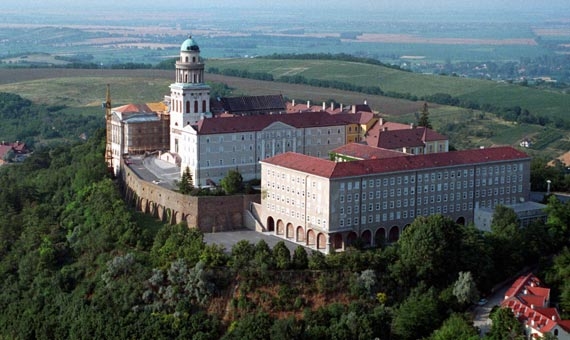En 996, des moines bénédictins avec l’aide du prince Geza, père du roi Etienne Ier, s’implantent sur la colline de Pannonhalma, lieu de naissance revendiqué de Saint Martin ( la rivalité avec Szombathely comme lieu de naissance est toujours d’actualité) et fondent un monastère qu’ils lui dédient. Vivant selon les règles édictées par Saint Benoît, ils évangélisent les Hongrois, créent la première école magyare et rédigent en 1055, le premier texte écrit en hongrois. Il s’agit la lettre de fondation de l’abbaye bénédictine de Tihany, sur le lac Balaton, en l’an 1055. Cette communauté monastique joue un rôle considérable dans la diffusion de la culture chrétienne en Europe centrale. Véritable forteresse, elle connait une histoire mouvementée avec trois occupations turques qui amènent les moines à fuir pour sauver les biens et manuscrits de l’abbaye, haut lieu de la connaissance de l’époque.
En 1786, Joseph II d’Autriche ferme les monastères mais rétablit en 1802 celui de Pannonhalma, à condition que les moines bénédictins enseignent. Depuis lors, l’abbaye est devenu un important Centre Universitaire, et a collecté pour sa magnifique bibliothèque de style néoclassique un fonds documentaire de plus de 350 000 volumes. Les guerres du XXe siècle et la période communiste ont épargné ce monastère classé au patrimoine mondial de l’UNESCO.
sa construction s’étend sur une longue période du XIII-XIXe siècle.
La partie la plus ancienne de l’abbatiale qui ait survécu est la crypte du XIII éme siècle, avec la trône de l’abbé : devenu tout simplement le « trône d’Etienne Ier » dans les coutumes locales. Le cloître de style gothique tardif, qui vient d’être restauré, ne fut construit que sous le roi Mathias Corvin (1443-1490). Dans son aspect actuel, l’abbaye date du début du XIXéme siècle. La haute tour à coupole néo-classique se voit de très loin dans la plaine pannonienne.
In 996, Benedictine monks, with the help of Prince Geza, father of King Stephen I, settled on the hill of Pannonhalma, the claimed birthplace of Saint Martin (the rivalry with Szombathely as the birthplace is still ongoing) and founded a monastery which they dedicated to him. Living according to the rules laid down by St Benedict, they evangelised the Hungarians, created the first Magyar school and in 1055 wrote the first text in Hungarian. This is the letter of foundation of the Benedictine abbey of Tihany, on Lake Balaton, in the year 1055. This monastic community played an important role in the spread of Christian culture in Central Europe. A veritable fortress, it had an eventful history with three Turkish occupations that led the monks to flee in order to save the abbey’s possessions and manuscripts, a mecca of knowledge at the time.
In 1786, Joseph II of Austria closed the monasteries but re-established the Pannonhalma monastery in 1802, on condition that the Benedictine monks teach. Since then, the abbey has become an important university centre, and has collected for its magnificent neoclassical library a collection of over 350,000 volumes. The 20th century wars and the communist period spared the monastery, which is a UNESCO World Heritage Site.
Its construction spans a long period from the 13th to the 19th century.
The oldest surviving part of the abbey church is the 13th century crypt, with the abbot’s throne: now simply the « throne of Stephen I » in local lore. The recently restored late Gothic cloister was only built under King Matthias Corvin (1443-1490). In its present appearance, the abbey dates from the early 19th century. The high neoclassical domed tower can be seen from far away on the Pannonian plain.

 "/>
"/>

